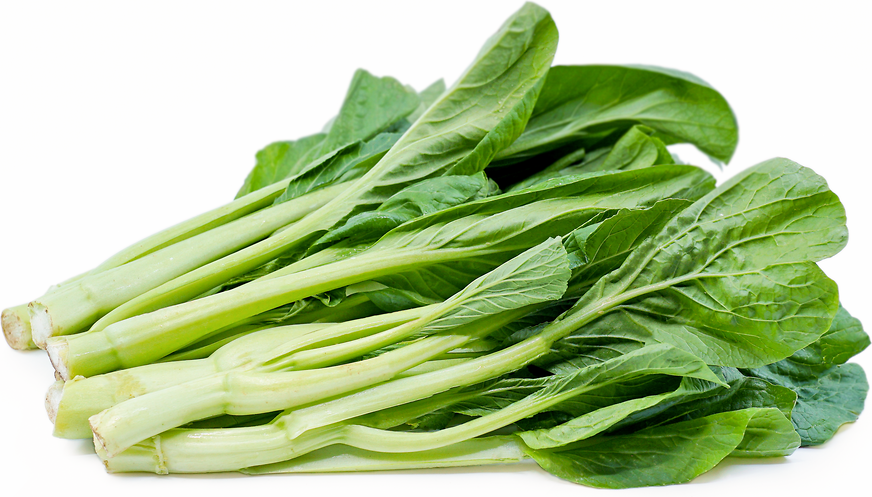


Choy Sum
Estimated Inventory, 30 lbs : 0
Description/Taste
Choy sum is a non-heading plant that has slender stems, averaging 15-20 centimeters in length, and oval, pliable leaves with yellow-flowering buds. The smooth stems are crisp, pale green, and firm, connected into broad, flat, and lightly serrated, green leaves. Choy sum also contains small, yellow flowers that are similar in appearance to gai lan and are also edible with a peppery, subtle mustard flavor. Choy sum is juicy, tender, and crunchy with a sweet, sometimes bitter taste. Depending on the age of the plant, the young stems tend to be sweeter while more mature stems bear a stronger, more pungent flavor.
Seasons/Availability
Choy sum is available year-round.
Current Facts
Choy sum, botanically classified as Brassica rapa var. parachinensis, is a flowering, herbaceous plant that is a member of the Brassicaceae or cabbage family. The term Choy sum is used in many different ways in Asia, depending on the region, and is also known as Choi sum in English, Cai xin and Tsoi sum in Chinese, Saishin in Japanese, Pakauyai in Thai, and Cai Ngot in Vietnamese. The term Choy sum is predominately used to refer to a non-heading plant that grows loose, leaf blades and is considered to be one of the most popular everyday vegetables consumed in China. There are multiple varieties found under the Choy sum name, including Green Choy sum, White Choy sum, and Hong Kong Choy sum. Choy sum can also refer to the center of a cabbage plant. Translating from Chinese to mean “the heart of the vegetable,” Choy sum is a term that has become a broad descriptor used in Asia to describe culinary dishes that utilize the heart or innermost section of any cabbage-like vegetable.
Nutritional Value
Choy sum is an excellent source of calcium, iron, and vitamins A and C, which are antioxidants that can help boost the immune system and protect the body against cell damage. It also contains fiber to help increase digestion and contains folic acid and potassium.
Applications
Choy sum is best suited for both raw and cooked applications such as stir-frying, blanching, and boiling. When fresh, Choy sum is utilized for its young leaves and stems and can be sliced and added to green salads or lightly tossed in dressing and sauces for a crisp side dish. The greens are more popularly cooked and are predominately used in Asian cuisine, lightly stir-fried with other vegetables and served with cooked meats, blanched and seasoned with oils and aromatics, or traditionally combined with other greens and used in soups and stews. The greens are also being increasingly used in fusion dishes and in new twists on classics such as pizza or casseroles. Choy sum pairs well with garlic, shallots, ginger, chiles, citrus, anchovies, bacon, duck, shellfish, legumes, potatoes, mushrooms, broccoli, carrots, snow peas, quinoa, cashews, peanuts, and vinaigrettes. The leaves and stems will keep 3-4 days when stored loosely in a bag and kept in the crisper drawer of the refrigerator. Choy sum can also be blanched and stored in the freezer for 8-12 months.
Ethnic/Cultural Info
In Hong Kong, Choy sum is one of the most popular vegetables used in Cantonese cuisine, which is a style of cooking originally from the Guangdong region of China. Hong Kong is comprised of a large Cantonese population, and the cuisine is reflective of the densely populated, modern lifestyle. Cantonese cuisine consists of using fresh ingredients, often seasonal, and lightly cooking them to enhance, but not mask the flavor of the ingredient. Locals also shop in neighborhood markets for the fresh ingredients and cook them daily as the standard home in Hong Kong is limited in storage space. In Cantonese cooking, Choy sum is lightly blanched and topped with oyster sauce, rice wine, soy sauce, or sesame oil, or it is stir-fried with garlic. To reduce waste, locals also use the blanched water from cooking Choy sum to make a soup stock, as soup is another traditional dish served between family and friends at meals.
Geography/History
Choy sum is native to mainland China and is believed to have been cultivated since the 5th century. As cultivation increased, many new varieties were created in China and were spread to neighboring countries such as Japan, Vietnam, and Thailand. Today Choy sum is one of the most popular vegetables found at local markets across Asia and Southeast Asia, and it can also be found at specialty grocers and Asian markets in Europe, Australia, and the United States.
Recipe Ideas
Recipes that include Choy Sum. One
| Roti & Rice |
|
Yu Choy Sum |
| SBS Australia |
|
Fried choy sum and snake beans with mustard greens |
| SBS Australia |
|
Tofu with mushrooms and choy sum |

















